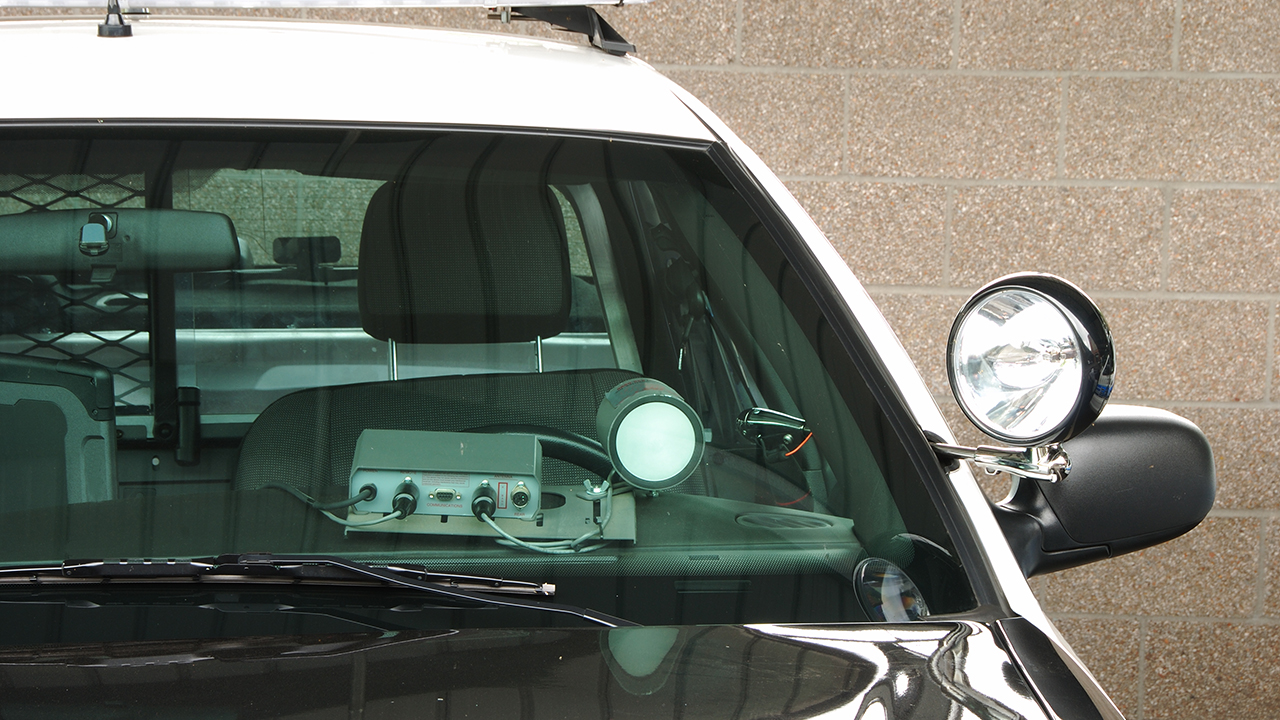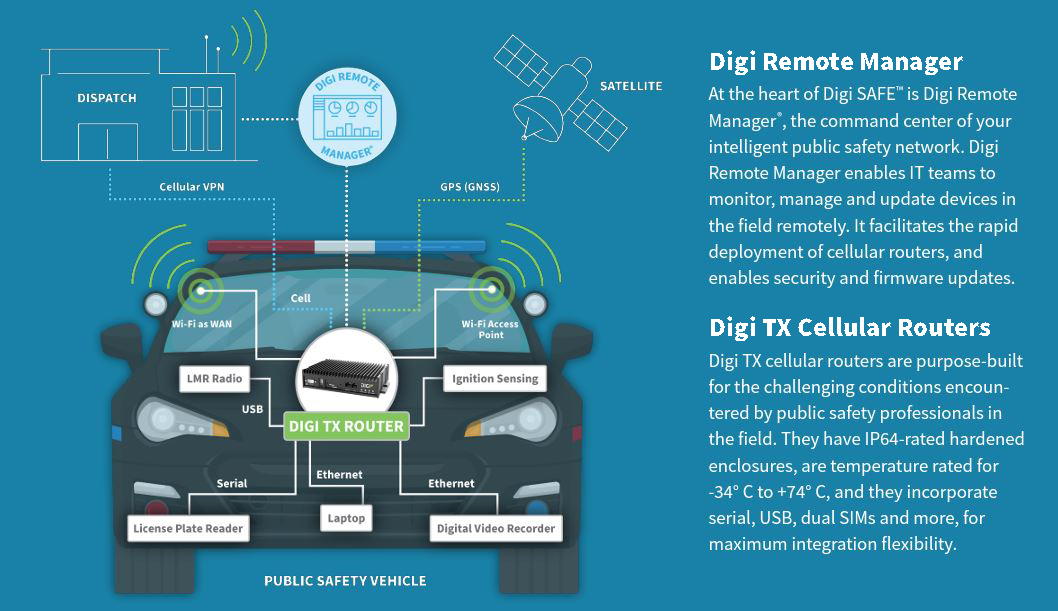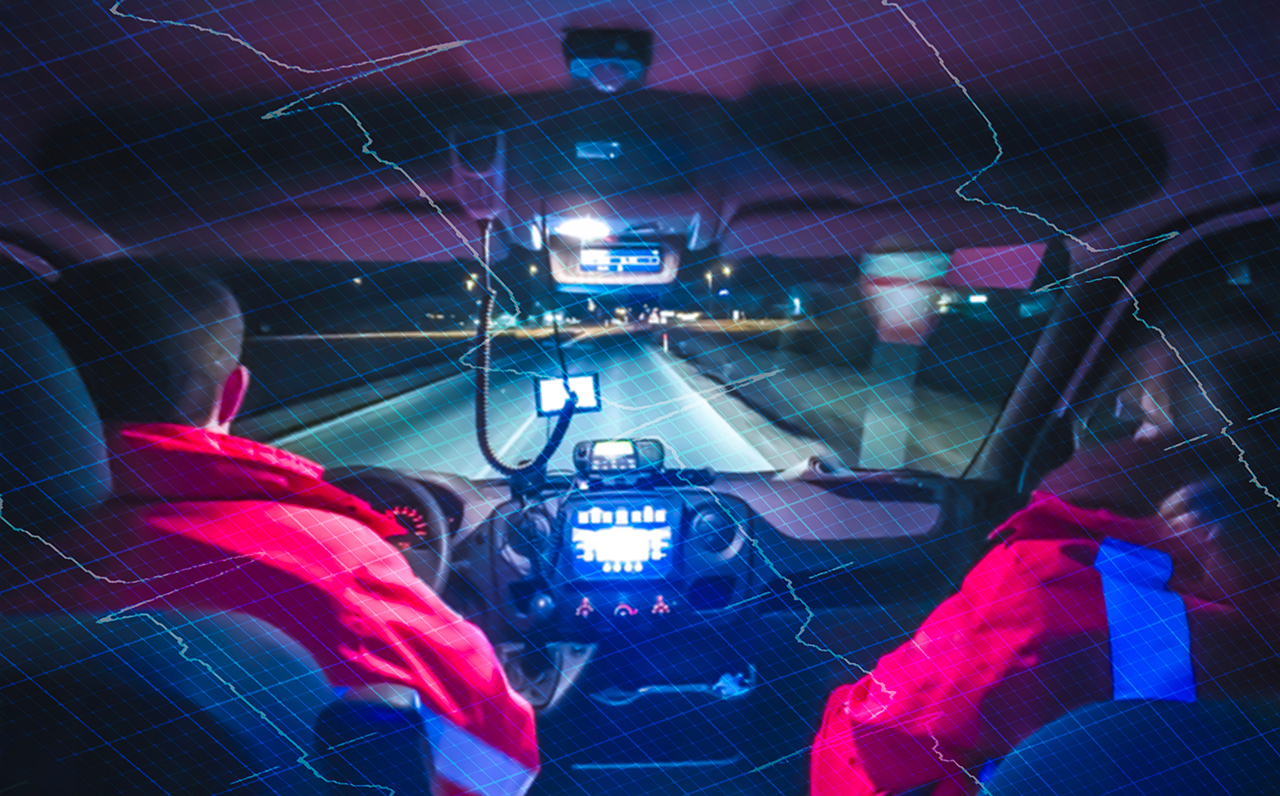One thing that every police, fire or emergency medical officer understands is that every second counts when people’s lives are at stake. Luckily, most emergency vehicles have onboard computers, routing, and communications networks for coordinating with dispatch centers and hospitals. They communicate through priority access public safety networks like FirstNet®, Verizon FrontLine and T-Mobile T-Priority. But many emergency response teams still struggle with emergency communications vehicle technology — especially managing the complexity, the cost, and the challenges involved in integrating multiple technologies while ensuring performance and reliability.
That’s where Digi can help. In this blog post, we explore key challenges and strategies for creating secure, always-on emergency vehicle communications first-responders require.
Challenges Facing Emergency Communications Vehicle Technology

Emergency vehicles have never been better equipped for improving situational awareness. Some vehicles contain many smart devices such as tablets, cell phones and laptops. Video streaming cameras and GPS systems help first responders react more quickly and safely. But more devices are not always better. Add associated data plans and a VPN for each device and costs escalate while bandwidth bogs down. When departments buy lower priced equipment to stay within budget, performance usually suffers. Finally, managing standalone devices creates complexity for IT.
Key Challenges
- Lean budgets — Sometimes, agencies must decide between purchasing technology or vehicles
- Too many devices — Many devices with separate logins can distract first responders
- Unreliable bandwidth and network quality — Emergency officers who lose network connectivity while responding to a call may not only lose precious time but may also risk their own safety
- Trouble communicating across agencies — Communication networks don’t always allow first responders to communicate with each other across agencies
A Complete Solution for Emergency Responder Vehicle Connectivity

Imagine reducing emergency response times by 35 percent and criminal incidents by up to 40 percent. That is the promise of smart technologies according to a McKinsey report. But, getting devices to connect in emergency vehicles is only part of the puzzle. The real opportunity is to build a complete solution for emergency vehicles. It starts with the network.
Critical Networks for First Responders
Digi SAFE solutions support all first responder networks, including FirstNet®, Verizon Frontline and T-Mobile T-Priority. These dedicated networks ensure first responders — as well as critical infrastructure systems, transportation and public safety teams — can continue communicating and providing services during large-scale emergencies.
In early October 2022, Hurricane Ian slammed the Florida Gulf Coast, and the FirstNet team was ready. The storm created widespread communications outages across the region. Thanks to FirstNet, first responders such as sheriffs, firefighters and search and rescue teams were able to communicate with each other as they conducted search and rescue missions.
Digi Cellular Devices for Emergency Response
Digi continues to grow and enhance its line of solutions for the critical needs of police, fire, and EMS departments of all sizes. In other words, Digi’s TX routers are purpose-built for mission critical mobile applications. Our emergency vehicle communications technology can operate during extreme events such as Hurricane Ian. The Digi TX line of routers apply specifically to transportation applications.
These routers include the latest-generation GNSS dead reckoning technology for more accurate location information than is possible with standard GPS. We offer cost-effective solutions that work great for smaller agencies. But we also provide rugged, high-performing routers ideal for SWAT cars and armored vehicles. Now, let’s think about hardware management and security.
Managing Always-on Connectivity for Police and Other First Responders

Lean budgets. Too many devices. Unreliable bandwidth. Lack of interagency communication. Digi built a secure, end-to-end solution for public safety professionals to solve these issues. We call it Digi SAFE™. Digi SAFE includes state-of-the-art software to ensure the security and performance of the network. Digi SAFE integrated hardware can withstand extreme conditions. Our solution is easy to use and priced for widespread deployment by police and fire departments of all sizes.
Here is how it works.
 First, Digi SAFE integrates sophisticated software and high-performance hardware that connects to priority cellular connectivity for major U.S. first responder networks. These include FirstNet®, Verizon FrontLine and T-Mobile T-Priority and other national and international public cellular networks.
First, Digi SAFE integrates sophisticated software and high-performance hardware that connects to priority cellular connectivity for major U.S. first responder networks. These include FirstNet®, Verizon FrontLine and T-Mobile T-Priority and other national and international public cellular networks.
The Digi communications hub provides wired and wireless connectivity in the emergency vehicle. It also distributes accurate location data to other systems in the vehicle and to dispatch. The hub produces a Vehicle Area Network through which other devices can connect. Best of all, Digi’s hub uses open ITxPT standards to reduce complexity and cost.
Mobile VPN software provides secure always-on connectivity. It uses session persistence and low data overhead on the vehicle’s communication hub and on an officer's smartphone. Session persistence allows applications to stay connected so officers can focus on their jobs.
Digi Remote Manager® (Digi RM) ties everything together. It is the command center for an intelligent public safety network. The Digi RM platform provides location information and enables the IT team to easily track, manage and update all Digi connected devices. Its alerting and over-the-air updating capabilities increase efficiency and reduce IT costs.
Three Levels of Security
Security is core to the Digi SAFE solution. Digi SAFE™ protects real-time communication and confidential data. It uses three interlocking rings of security.
- Digi TrustFence® — A security framework that integrates device security, device identity and data privacy capabilities
- FIPS 140-2 Certification — Digi SAFE cellular routers (coming soon) meet the strict Federal Information Processing Standard 140-2 (FIPS 140-2) for cryptographic modules
- CJIS-compliant Mobile VPN — Digi SAFE includes a mobile VPN solution from Radio IP. Radio IP is a trusted partner with decades of experience.
Why Digi SAFE
Digi SAFE integrates sophisticated software and hardware in one complete solution. We designed it to address common emergency responder pain points. Best of all, it is easy to get started and any sized emergency response agency can deploy it.
Digi SAFE is:
- Reliable and always connected — Supports the full range of in-vehicle devices found in many police vehicles. It increases uptime and improves situational awareness.
- Purpose-built for public safety - State-of-the-art software ensures network security and performance. Ruggedized hardware built specifically to withstand extreme environmental conditions.
- Easy to integrate — Easy to use, deploy, scale and integrate—by design.
- Cost-effective — Designed for widespread deployment, volume pricing options are available.

Emergency communications vehicle technology is ubiquitous. And it promises to significantly improve situational awareness and response times. But deployment and management are still too complex. An officer in the field should be able to easily use the platform as much as dispatch, the station, and the IT staff.
Digi studied emergency vehicle technology pain points and then built an elegant solution. Our integrated solution is always on, always connected and always secure. It is also easy for your IT team to deploy and manage. We’ll provide everything you need to get started. Take the next step to learn how we can become your emergency communications vehicle technology partner.
Next Steps